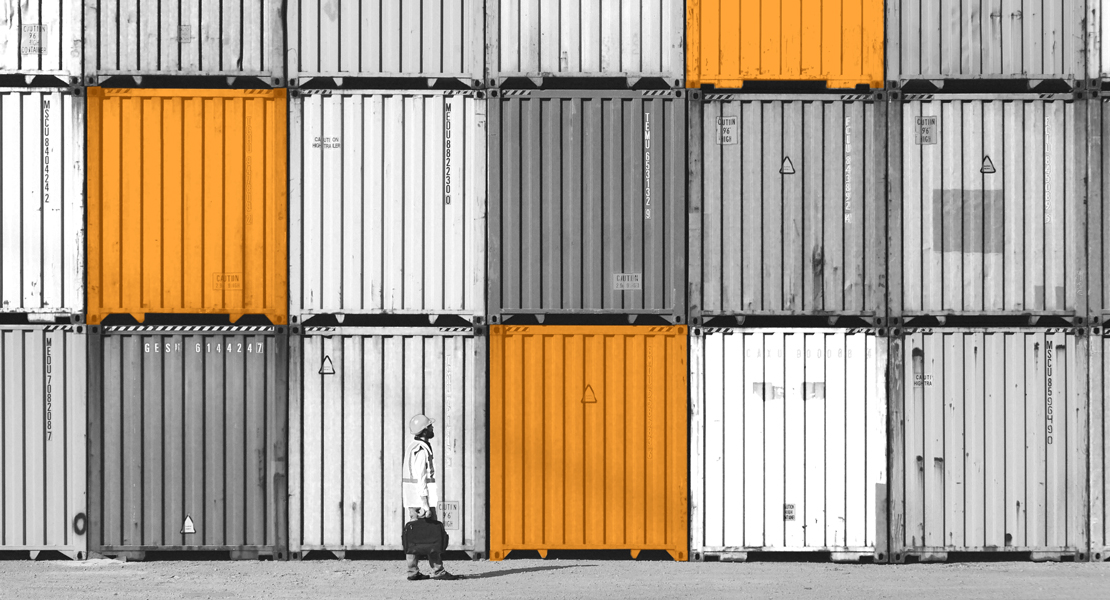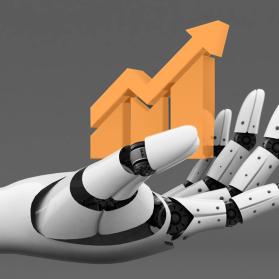The Covid 19 pandemic has hit large parts of the economy hard: Demand has collapsed in many sectors and lockdown measures have affected many supply chains on a massive scale, especially at the beginning of the pandemic. In the short term, this required activities to gain transparency and secure production and material supply from suppliers. In the medium term, effective measures must be taken to safeguard key supply chains against future disruptions such as trade wars, Brexit or climate change, as their probability of occurrence has increased significantly. Technologies from digitalisation can provide valuable support in this regard.
Covid-19 has affected economies around the world to an extent that hardly anyone would have thought possible before. The lockdown severely curtailed both public and economic life. Distance rules and the shifting of work to home offices where possible restricted everyday life. Ever new waves caused the withdrawal of relaxations and forced the adaptation of ever new regulations (e.g. Click&Meet in retail).
The associated uncertainties for workers led to private purchasing restraint, especially for higher-priced purchases, and thus to a considerable weakening of demand. On the supply side, too, there were delays in deliveries and consequently production stoppages, although the supply of food and everyday consumer goods to the population in the industrialised countries could be maintained almost without restriction. Covid-19 thus drastically affected demand and supply chains alike.
In the wake of the decline in Covid-19 infections, gradual relaxations have come into effect. Governments have put in place stimulus packages to stimulate domestic demand and protect jobs. So what does this mean for companies? How well has risk management worked to secure their own supply chains? How should they prepare for the post-pandemic period? What are the "lessons learned" from the crisis and what does this mean for the future?
Stable supply chains ensure companies' ability to survive
Whether the company's risk management could have foreseen the dangers of a pandemic in general and specifically in the case of Covid-19, remains to be seen. The SARS outbreak in Asia in 2002/2003 had shown the principle danger of a sudden epidemic and was classified by the WHO as a worldwide threat. However, since the consequences of the outbreak at that time were relatively small compared to Covid-19 and were also geographically limited, this led to the implementation of corresponding preventive measures in very few companies.
The question of whether the risk of global pandemics will increase in the future will have to be answered by experts when the origin and consequences of the SARS-CoV-2 virus have been analysed and understood in sufficient depth at a later date. However, the need for companies to make their supply networks more stable and resistant to external influences in the future is already apparent. After all, the frequency and speed with which events such as natural disasters, social unrest, trade wars and protectionism with a potentially large negative impact on companies can occur are undeniably increasing.
This is contrasted by increasingly sophisticated logistics chains with collaborative planning processes (S&OP), reduced inventories, just-in-time/just-in-sequence delivery and the consistent exploitation of comparative cost advantages by relocating production to low-wage countries. All measures that are more likely to make a supply network more vulnerable than more robust. Covid-19 demonstrated this drastically in many places.
Yet some companies manage to maintain even such complex supply chains during the Corona crisis. Why is this so? What measures can be taken to make supply networks more robust and flexible?
Demand planning is essential for managing the entire supply chain
A realistic and timely assessment of expected customer demand is essential for managing the entire supply chain, both within the company and in the supplier network. The forecasting methods used by planning systems to determine customer demand are overwhelmed with assessing the effects of a drastically and rapidly changing market demand, as triggered by Corona in some industries. Shifts in market demand due to rapidly changing customer demand behaviour can also hardly be forecast. However, since an exact picture of the expected market development and the short- to medium-term customer needs derived from it is important, new ways and approaches must be found here.
In the short term, the expertise of the sales staff is primarily required to check the plausibility of the results from the planning systems and to adjust the planning parameters taking into account crisis-related and in this form unforeseeable special effects such as slumps in demand, shifts in the demand structure or "hoarding purchases". In this context, communication via market channels, direct contact with customers as well as recourse to market analyses by external business services can provide valuable clues, for example, to correctly assess the timing of a resurgence in customer demand. This also requires continuous monitoring of economic developments in the sales markets affected by the crisis. Suppliers are particularly dependent on the forecasts and prognoses of their direct customers, as they lack direct contact with the customer of the end product in B2B business.
Consequently, the continuous exchange of information to increase transparency between all companies along the supply chain is of great importance. With the help of digitalisation, suppliers at the downstream levels are increasingly succeeding in establishing "digital touchpoints" with end customers themselves and using these to estimate the development of demand.
In the medium to long term, it must be examined how early warning indicators can be derived from the course of the crisis in order to be better prepared for similar events in the future. These early warning indicators must be included in the supply chain's risk management and continuously monitored there. However, in order to be able to interpret their progress correctly and to define threshold values for warnings appropriately, the course of the Corona pandemic in one's own company must be recorded, including the experiences made, the data collected and the measures that proved to be effective.
Scenario techniques can be helpful here in order to map the course of the pandemic in one's own company in a model-typical way and, on this basis, to make the development of the early indicators and the resulting customer demand effects comprehensible. Modern risk management software solutions support this. They facilitate the recognition of dependencies and the derivation of cause-effect chains, among other things, by using artificial intelligence in the evaluation of the data material, for example, through pattern recognition procedures.
The processing of the perception of the crisis and the recognition of the indicators relevant to the company for a "what if" consideration must be linked to the appropriate countermeasures in order to arrive at a master plan. Only the linkage helps to identify dangerous developments at an early stage, to gain time for appropriate countermeasures and to avoid having to make the same considerations a second time by resorting to documented best practices. This also includes the early detection of a resurgence in customer demand and the associated measures for adjusting planning systems, communicating with suppliers and restarting production.
Creating transparency about the supply chain
Once sales planning has been hardened in this way, production and logistics are included within the framework of integrated Sales & Operations Planning (S&OP). Here, too, the usual procedures reach their limits in a crisis, because the usual security of supply of important components can no longer be assumed. It is imperative to gain transparency about which components and/or services are indispensable for maintaining one's own production. This is the first priority and provides the basis for the subsequent analysis regarding the security of supply and, based on this, the derivation of which end products can only be produced in reduced quantities or not at all. The value contribution of the parts in question for the company must also be taken into account in order to be able to decide which end products should be manufactured for which customers in the event of bottlenecks.
In the short term, a cross-departmental team from production, logistics and purchasing can be set up for this purpose in order to determine a classification of the criticality of the parts and their value contribution on the basis of the parts list items. The subsequent analysis of the supply situation for the identified critical material groups or services is then carried out by logistics and purchasing in close communication with the suppliers concerned. If bottlenecks are identified or threatened, the identification of the parts stocks available in the own company and at the suppliers as well as the quantities in transport will help in the short term. Safety stocks and stocks from the spare parts supply must also be taken into account. If these are also insufficient to cover the demand, the only solution is to look for alternative materials and/or suppliers.
However, in order to gain transparency over the entire supply chain, the analysis must not be limited to the immediate first-level suppliers, but must also refer to their suppliers in the same way. The risk of supplier failure is usually significantly higher at the sub-levels of the supply chain than with the company's direct suppliers. To counteract this, it is particularly important to share the necessary information on demand, supply capacities, stocks and utilisation in the partner network. This may meet with reservations on the part of suppliers, as they could see their freedom of movement restricted by too much openness. This conflict of objectives must ultimately be resolved on a contractual level between supplier and customer. On the other hand, early identification of impending bottlenecks also allows the supplier to be supported in overcoming them by the purchasing company.
In the medium to long term, it is necessary to store criticality in different degrees of hardness and the value contribution of a material or pre-product in the master data. This can be done in the form of a parts atlas, which is the basis for an application-supported assessment of value contribution and risk. In this way, manual efforts in the ad hoc-driven procedure can be replaced by the generation of corresponding reports from the ERP systems, which leads to a considerable gain in time and enables a more agile procedure.
In addition, the goal must be to create a digital image of the supply chain, including its geographical distribution and taking into account the transport routes. On the one hand, it provides the basis for monitoring the flow of goods and on the other hand, it forms the basis for simulating impending crises or disruptions in the future. The use of cloud platforms enables cross-company collaboration and a central view of the same data for all partners. For example, more and more companies are participating in the Automotive Alliance "Catena-X Automotive Network (Catena-X)", a network for cross-company data exchange in the automotive industry. The founders of the partner network include BMW AG, Deutsche Telekom AG, Robert Bosch GmbH, SAP SE, Siemens AG and ZF Friedrichshafen AG. The goal is to create a uniform standard for data and information flows in the entire automotive value chain. The technologies for digitalisation and further automation of production as part of the development of the Smart Factory and its mapping as a digital twin also pay off in terms of increasing transparency along the entire supply chain, while also safeguarding the legitimate interests of all parties.
Optimise supply networks towards resilience
Once the transparency of the supply chain partners has been established, the next step is to review their resilience and then optimise them where necessary.
In the short term, it is important to ensure the best possible direct supply of goods and services identified as critical, both from direct suppliers and from sub-suppliers. Here, the exchange of information along the supply chain is of decisive importance. The best possible transparency about planned requirements and delivery times in an adjusted rolling forecast "downstream" as well as information about current production capacities and warehouse stocks and the short-term identification of supply bottlenecks or logistics problems "upstream" determine action and the exchange of information in crisis mode.
In the medium to long term, however, ad hoc action must be replaced by planned action - if only to conserve one's own resources. This requires a risk assessment for the entire supply network, which also takes into account geographical and logistical risks in particular. The starting point for this is usually the 360-degree assessments of the suppliers. If the suppliers for critical product groups are located in high-risk areas or are geographically concentrated in a few locations, this represents a high risk of default. This can either be solved by the suppliers themselves in the long term through dialogue with them or requires the company to actively search for additional suppliers to achieve the necessary geo-redundancy. To what extent Covid-19 will result in general structural shifts in the relocation of production sites remains to be seen.
In this context, a precise analysis of the transport routes is also necessary in order to minimise logistical risks due to considerable delays at logistical hubs such as ports or airports through diversification. Reasons for this can be, for example, limited resources in quarantine zones, staff shortages due to the pandemic, lack of container storage space or empty containers, transport routes changed at short notice or the failure of logistics providers. And even if the required material is delivered by the supplier just over the border in the neighbouring country, this can suddenly become a problem if border traffic is restricted or extreme traffic jams form due to more complex clearance processes. The intra-European border controls and in some cases closures that were reintroduced in many cases in the wake of the pandemic were not considered as an option in most logistics concepts in the Schengen area. And there are also more and more voices asking whether these were the right measures. The EU Commission, for example, is now talking about "overreactions" and is seeking an amendment to the agreement that would reduce the possibilities of temporary border closures.
In general, for a robust supply chain there should always be at least two suppliers with geographically separate production and delivery locations. The closer the suppliers are to the company's own production sites, the greater the likelihood of being able to maintain supplies even in the event of drastic events such as Corona. Examples of this can be found in the automotive industry, where important core suppliers are usually located with their production sites in the immediate vicinity of the plants. The additional costs arising from a regional supply must be balanced against the assessed risks of a longer production stoppage due to supply bottlenecks - this is also a task of risk management, which has become all the more important.
Impending or already occurred production losses due to lack of demand can - even if they are only temporary - massively burden the financial stability of suppliers. Consequently, the continuous monitoring of key financial figures based on publicly available sources, balance sheet analyses, processed data from economic services and the scanning of news in social media has become even more important.
If bottlenecks become apparent with key suppliers in the supply chain, the company must weigh up whether measures to stabilise the supplier are not more beneficial on balance than building up and integrating new suppliers. Here, too, the importance of transparency along the entire supply chain becomes apparent, as it warns the partner at an early stage regarding impending difficulties and thus opens up options for action before the baby has fallen into the well. Ultimately, however, scenarios in the event of insolvencies of critical suppliers must also be thought out in advance and kept up to date in order to maintain the company's own production.
But not only externally, but also internally, Purchasing, in cooperation with Production and Product Marketing, can achieve measures to reduce dependencies on suppliers and thus increase resilience in material supply within the framework of product engineering. Resorting to simpler components or those for which there are several, possibly also regionally available suppliers, can ensure a reduction in risky dependencies on critical suppliers as early as the product design stage.
Managing the restart and learning from the crisis
After the decline in the number of infections in the first wave, companies were able to restart production in the summer of 2020 in most cases. In many cases, however, production volumes were significantly reduced due to hygiene and safety measures that limited the number of workers in the production halls and slowed down processes, as well as due to supply chains that had not yet been fully restarted. In addition, there were bottlenecks in the semiconductor industry, which led to production stoppages in the automotive industry in particular. The recovering demand in some areas, especially due to trade also slowly opening up again, can therefore not be fully met for all products. And many raw materials have become much more expensive as a result of the crisis, which has led to sharply increased prices or shortages of building materials in many subsequent industries from manufacturing to construction.
The effects of the Corona crisis have led to a severe economic crisis, the consequences of which the governments of many countries are trying to mitigate with comprehensive economic stimulus and aid programmes. How this will affect private consumption and businesses cannot be predicted with certainty at this point in time. Likewise, the further course of the pandemic remains uncertain, at least as long as the vaccinations have not been carried out across the board and it is unclear to what extent virus mutations can lead to illness even despite vaccination. Consequently, companies will have to cope with high uncertainties for the foreseeable future.
Nevertheless, developments can already be seen that will lead to changes in supply networks in the post-Corona era. The need to make supply chains more transparent and robust against external disruptions is unmistakable. In these times of rapidly advancing digitalisation and automation, the necessary tools, processes and technologies are increasingly available to get close to this goal.
Another aspect for the future-proof design of supply chains and logistics concepts is the "Supply Chain Act" passed in March 2021. The Federal Cabinet has passed a "draft law on corporate due diligence in supply chains", whereby German companies are obliged to fulfil their global responsibility for better environmental and working conditions. Since Germany is particularly strongly involved in international supply chains and raw materials of many products as well as products themselves are mined and manufactured under unacceptable environmental and working conditions in developing and emerging countries, there is a great need for companies to take action here.
The German Supply Chain Act will initially apply to companies with more than 3,000 employees from 2023. One year later, it will also apply to companies with more than 1,000 employees. According to the UN Guiding Principles on Business and Human Rights, companies are obliged to determine the extent to which their business activities can lead to human rights violations. Due diligence refers to the entire supply chain of the company - from the raw material to the finished product for sale.
This means that transparency must be created across the entire supply chain and production must be aligned more strongly with the sustainability dimension in the sense of the so-called triple bottom line. In addition to the social dimension with regard to the supply chain, the ecological dimension is also playing an increasingly important role. Companies need to evaluate and understand their supply chains in detail and create transparency.
Digitalisation and automation provide the necessary tools, processes and technologies
In an ideal case, a supply network is supported by a digital image. This digital twin can provide the necessary transparency about the supply network in real time. Smart analysis tools - using artificial intelligence if necessary - detect deviations and identify risks. A simulation module can be used to develop scenarios and derive possible courses of action. In the event of a crisis, concrete proposals are then available that can be implemented quickly and greatly increase the resilience of the supply network.
In very few cases was such a digital twin ready at the beginning of the Corona crisis. The few existing examples clearly show how much support this can provide for one's own business. It is therefore worthwhile to start building it up in any case. In a first step, it is sufficient to compile all information about one's own supply network in digital form. From this, a first version of the digital image can then be developed in the short term.
However, technology alone will not be sufficient in some sectors to achieve the desired resilience. Structural changes in the supply chains will also be necessary, for example through the diversification of the suppliers used, possibly in conjunction with the increased use of regional suppliers to reduce geographic/socio-economic and logistical risks. But also the redesign of contracts to achieve more transparency and a strengthening of the partnership between customer and supplier is an option.
This makes four things important for companies:
- Improving the ability to understand and forecast customer needs even in the face of drastic events.
- Building transparency, especially through digitalisation and resilience in supply chains from an end-to-end perspective.
- Expanding risk management and collaboration with suppliers and their sub-suppliers along the entire supply chain, also in terms of the Supply Chain Act.
- Learning from the crisis and safeguarding the lessons learned and the successful countermeasures taken in order to have them operational and available in case of future occurrences.
To achieve these goals, it is useful to look at the capabilities that the company lacked in the peak phase of the crisis, had to build up in a short period of time or are now needed for the phase after the pandemic shock after leaving the ad hoc-driven action. On the basis of a capabilities map, the current level of maturity can be recorded and fields of action can be identified holistically and consistently. In the next step, suitable measures, procedures and digitalisation technologies can be identified for the capabilities that urgently need to be improved in order to quickly achieve the desired improvements. These then form the basis for project planning, comparison with projects already set up in the company and the derivation of a resilience-oriented implementation roadmap.
This procedure should be flanked by "lessons learned" workshops to review the procedure during the crisis and to identify the contents and procedures that should be recorded in terms of business continuity and prepared for the future.
For the companies, a variety of measures can be derived from the Covid 19 pandemic that are suitable for preparing for significant disruptions in the supply networks to be expected in the future and counteracting these through increased resilience in their own company as well as in the entire supplier network. Digitisation and automation can contribute a great deal of value here if they are used in a targeted manner and in the right places. Capability maps and heat maps offer a suitable stable framework for increasing transparency, resilience and digitalisation in a targeted manner and to the required extent. "Lessons learned", best practices and measures introduced can thus always be clearly assigned and their impact evaluated.








